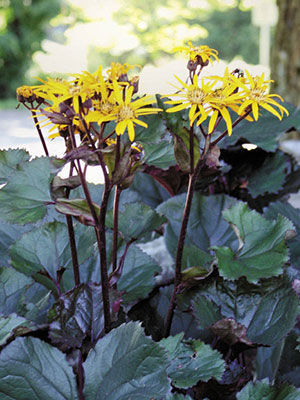1. ‘Gold Heart’ Bleeding Heart

Name: Dicentra spectabilis ‘Gold Heart’
USDA hardiness zones: 3 to 9
Size: 2 feet tall and 3 feet wide
Conditions: Morning sun to full shade; rich, moist soil
In early spring, the new foliage of ‘Gold Heart’ bursts through the cold, dark soil, glowing like sunlight. It holds that color for most of the season. Flower buds appear in April and bloom the same color as regular bleeding hearts, with the deep pink of the flowers echoed in the pinkish stems.
2. ‘Britt-Marie Crawford’ Ligularia

Name: Ligularia dentata ‘Britt-Marie Crawford’
Zones: 4 to 8
Size: 3 feet tall and wide
Conditions: Morning sun to light shade; rich, moisture-retentive soil
This plant is all female—buxomy and curvy in a dark chocolate–colored satin gown. The dark, glossy foliage of ‘Britt-Marie Crawford’ is the perfect companion for dramatic color combinations in the garden. Want shocking contrast? Pair it with bright chartreuse. Want soothing contrast? Pair it with chalky blues and silvers. ‘Britt-Marie Crawford’ needs constant moisture to be happy. The bright golden flowers that appear in summer can be cut off if you find them offensive or distracting.
3. Tiger Eyes® Cutleaf Staghorn Sumac

Name: Rhus typhina ‘Bailtiger’
Zones: 5 to 9
Size: 6 feet tall and wide
Conditions: Full sun to partial shade; tolerates average to poor soil with average to dry moisture
Tiger Eyes® is one supersexy plant: lush and tropical looking yet a native that’s at home in almost any garden scene. The finely divided, golden-and-chartreuse leaves do double duty, providing exciting color and energetic texture. After a couple of years, Tiger Eyes® will sucker a good deal. Cut the suckers off, dig them up to share, or pot them up in cobalt blue containers for a stunning color combo. In fall, the leaves develop shades of orange, often touched with scarlet. In winter, the fuzzy, coarse stems and branches make this a four-season focal-point plant.
4. Cup Plant

Name: Silphium perfoliatum
Zones: 5 to 9
Size: 6 to 10 feet tall and 3 to 6 feet wide
Conditions: Full sun; average to rich soil with average moisture
A big, bodacious prairie native, this huge yellow daisy makes a statement in the garden. Coarse, bold-textured leaves attach in pairs around the square stems, creating the cup in its name. The bright, 3-inch-wide flowers are showy from July to September. In rich, moist soil, you may need to stake this plant. I deadhead mine because it reseeds quite a bit, but the seed heads could be left for birds to snack on. Going native was never so rewarding.
Irvin Etienne is the horticultural display coordinator at the Indianapolis Museum of Art in Indiana.
Photos: #2, #3 and #4 Michelle Gervais; #1, Brandi Spade


















Comments
Log in or create an account to post a comment.
Sign up Log in